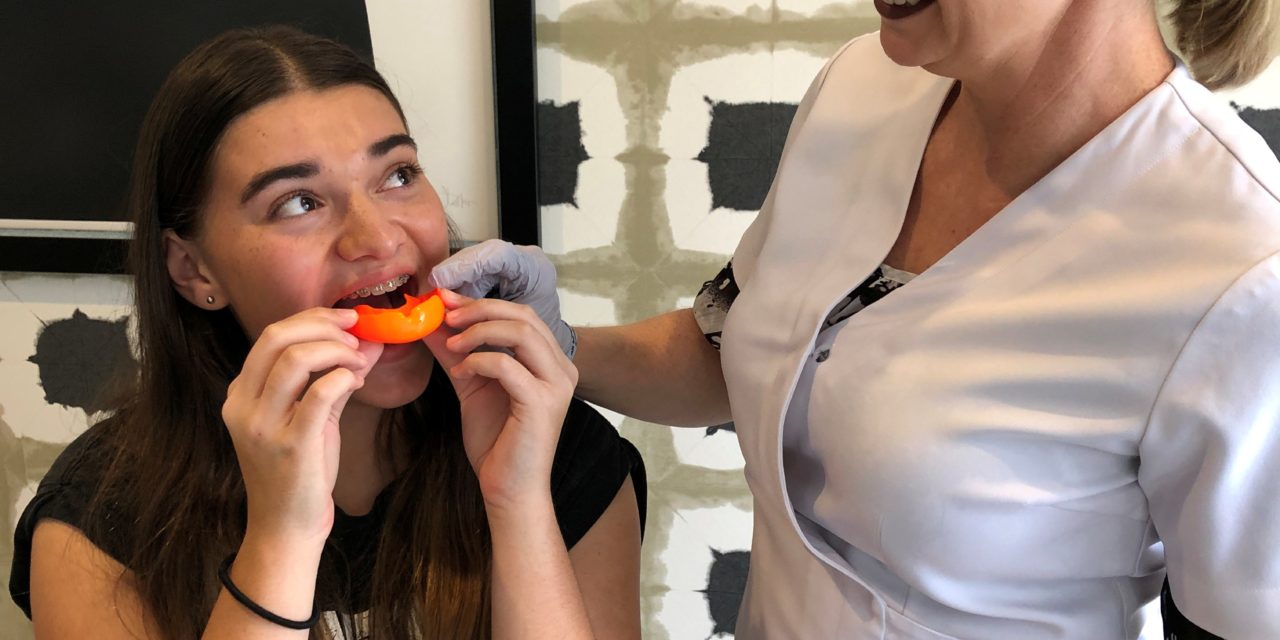Parents are being warned to make sure their child isn’t one of the thousands who will be treated for dental injuries from sport this Winter by choosing a quality mouthguard.
Dentist Dr Kristina Cain says with the rise in popularity of contact sports for both sexes, children need to be protected with a proper-fitting mouthguard: “it’s a small investment with a big return”.
According to Orthodontics Australia, only a third of children aged five to 17 years wear a mouthguard while playing sport, even though other protective materials like helmets are common.
“A custom-fitted mouthguard absorbs and spreads the impact of a blow to the face, which could otherwise cause injury to the mouth or jaw,” said Dr Cain.
“Children often need to take time off school to recover from dental injuries. They can be painful, disfiguring, and traumatic, and may lead to long and complicated dental treatments,” she said.
The Australian Dental Association says thousands of children are treated for injuries to their teeth and soft tissue of their mouths every year – but these injuries could be avoided if they wore mouthguards.
“The cost of these injuries is far greater than the cost of a mouthguard,” said Dr Cain.
A child’s age, the sport they play, teeth development and whether they have orthodontic appliances all need to be considered when fitting a mouthguard.
Dr Cain advised mouthguards fitted properly by a dentist were far superior to ‘ready-made’ or ‘boil and bite’ versions, because they were specially fitted to a child’s teeth and jaw.
“You can’t be sure you are getting 100% coverage over the teeth with off-the-shelf versions some of which are put in hot water to mould, but some areas don’t heat as well as others,” said Dr Cain.
“Children have so many different teeth coming through, some are not all the way through, so a generic fit is not appropriate,” she said.
“The teeth impressions taken by a dentist for a custom-fit version are constructed to fit kids’ mouths properly, they are comfortable and have a quick turnaround at the labs.”
Tips to make sure your kids’ teeth are safe this winter:
- Invest in a quality mouthguard: Impacts from other players, hard falls onto fields and floors, and balls hitting the face can chip or break teeth, cut the gums, and twist expensive orthodontic appliances.
- What to look for in a mouthguard: A custom-made mouthguard fits far better than an off-the-shelf variety, and as a result offers more protection.
- If a custom-made mouthguard isn’t available: Buy one off-the-shelf in a size that’s close to the size of your child’s mouth. Larger is better, and a soft mouthguard can be trimmed for a better fit.
- Always opt for a soft mouthguard: These distribute the force of impact more evenly than rigid plastics and shouldn’t become dangerous projectiles inside the mouth.
Dr Cain says children of all ages can be fitted with mouthguards, but it’s best to get them used to wearing mouthguards from an early age. They should be worn in training sessions and on match days if there’s a risk of knocks or falls – in both contact and non-contact sports.
“Every sport requires a different mouthguard thickness, and they have to be remade every year at least to get a proper fit with proper protection for every tooth,” said Dr Cain.
“I’ve witnessed some horror sports-related accidents working on kids in the dentist chair,” she said.
“Young AFL players who have been smacked in the face by a kick and their front teeth pushed into the jawbone. This can kill or break the tooth as well as damage or fracture the jaw, some kids lose the teeth altogether.”
“If baby teeth are pushed in at a time when adult teeth are under the surface, this can damage the adult tooth as well, with yellow or brown spots or a breakage.”
Split lips can also require stitches, with outside of mouth scars and even trips to emergency and the plastic surgeon.
How to care for mouthguards:
- Always keep in rigid containers when not in use and keep away from heat sources to prevent warping and softening.
- Clean after every use with a non-abrasive toothpaste to prevent the growth of bacteria.
- Check fit and damage with a dentist yearly and replace as needed. Even if the mouthguard is well maintained, your child’s mouth is still growing and changing shape.
Mouthguards should:
- Be thick enough (5 mm) to provide protection against impact.
- Fit snugly and comfortably.
- Be odourless and tasteless.
- Allow normal breathing and swallowing.
- Allow normal speech.
Mouthguards are claimable under health funds; they range in price from around $100 to $300.
Dr Cain says if children are reluctant to wear them, point out their favourite sporting stars who do.
Dentists will do better deals for fitting entire teams, and mouthguards now come in a range of colours and flavours to make the experience exciting for kids.
About Dr Kristina Cain
Dr Kristina Cain completed her studies at the University of Queensland and has over 23 years’ experience as a dental practitioner. She has worked in private practices around Australia and enjoys treating patients from all walks of life.
Dr Cain has a special interest and flair for cosmetic enhancements, implant crowns, crown and bridgework, QST (quick straight teeth) and especially facial aesthetics. Formerly a trainer for the Australasian Academy of Dento-Facial Aesthetics (AADFA), Kristina is now a Fellow of the International Academy of Dento-Facial Aesthetics (IADFE) in New York, USA.
She is also a Dental Consultant on the Dental Advisory Panel for Experien to assist other dentists. Kristina strongly believes that the prevention of dental and facial degeneration is the key to happy and healthy patients.
For more information visit Refresh Dental Spa: www.refreshdental.com.au



